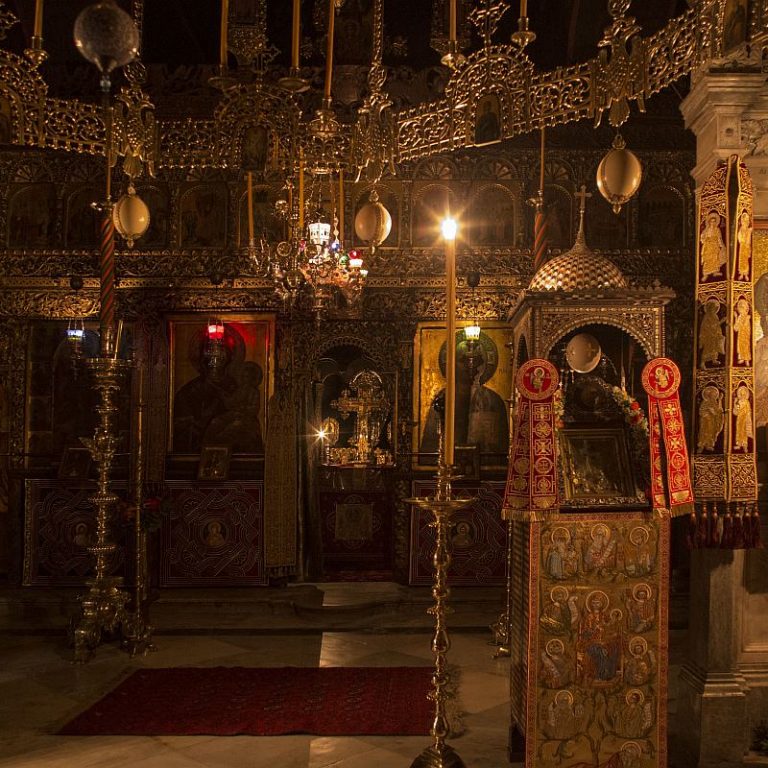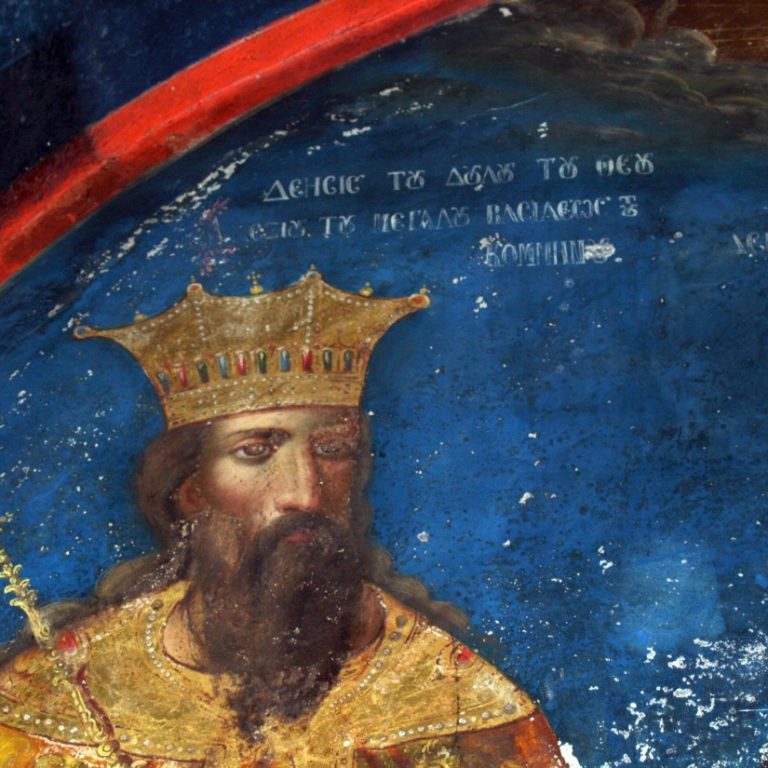The Nave
The original church was officially opened around 1363. The marble inscription which today is engraved into the stairway leading from the outer entrance of the church to the bell tower: 'Lord, remember thy servants Alexios and Ioannios, the owners and brothers. Dedicated in the year 1363.'
Four marble columns support the central dome, simultaneously forming the northern and southern dome-topped apses. To the left and right of the nave, at approximately its centre, two marble shrines are located. The shrines, completed in 1896, are the work of the sculpture Georgios Filippotis from Tinos, and were gifts from the monks Akindinos of anti-Andros and Theofilos of Lesbos.
It is worth noting that the presence of the large (1.96 x 0.76 metres) icon in the central nave is truly unique, since it depicts the Blessed Mother full length, with her right hand open in a gesture of open-heartedness, in the Αγιοσορείτισσας (Agiosoreitissas, 'Holy woman') style. According to the Monastery tradition, the icon had been brought from Konstantinople by the owners at the time the physical foundations of the cathedral were being laid. They placed the icon at the spot they had chosen, and the work began. The next morning, however, the icon was found at the location where the Monastery stands today. The workers replaced the icon in its original location and continued work. The next day, the icon was once again found in the present-day location of the Monastery. After a third repetition of this miracle, the owners built the Monastery in the location which had been chosen by Panagia. The original location selected by the owners has been identified as the spot where the chapel of the Great Athanasios exists today, approximately 500 meters northwest of the Monastery.
According to tradition, the silver embellishment of the icon, which had been made in Moscow in 1847, was a gift of a noblewoman from Konstantinople who had been asked by Panagia to donate it.
Yet another shrine, next to the marble shrine on the right of the nave where the icon of the festal saint is situated, was dedicated by the hieromonk Anthimos of Sifnos in 1716. It is decorated with inlaid ivory and tortoise-shell, and is recorded in relevant documents as having been made in Kaffa (Theodosias-Theodosioupolis).
Four marble columns support the central dome, simultaneously forming the northern and southern dome-topped apses. To the left and right of the nave, at approximately its centre, two marble shrines are located. The shrines, completed in 1896, are the work of the sculpture Georgios Filippotis from Tinos, and were gifts from the monks Akindinos of anti-Andros and Theofilos of Lesbos.
It is worth noting that the presence of the large (1.96 x 0.76 metres) icon in the central nave is truly unique, since it depicts the Blessed Mother full length, with her right hand open in a gesture of open-heartedness, in the Αγιοσορείτισσας (Agiosoreitissas, 'Holy woman') style. According to the Monastery tradition, the icon had been brought from Konstantinople by the owners at the time the physical foundations of the cathedral were being laid. They placed the icon at the spot they had chosen, and the work began. The next morning, however, the icon was found at the location where the Monastery stands today. The workers replaced the icon in its original location and continued work. The next day, the icon was once again found in the present-day location of the Monastery. After a third repetition of this miracle, the owners built the Monastery in the location which had been chosen by Panagia. The original location selected by the owners has been identified as the spot where the chapel of the Great Athanasios exists today, approximately 500 meters northwest of the Monastery.
According to tradition, the silver embellishment of the icon, which had been made in Moscow in 1847, was a gift of a noblewoman from Konstantinople who had been asked by Panagia to donate it.
Yet another shrine, next to the marble shrine on the right of the nave where the icon of the festal saint is situated, was dedicated by the hieromonk Anthimos of Sifnos in 1716. It is decorated with inlaid ivory and tortoise-shell, and is recorded in relevant documents as having been made in Kaffa (Theodosias-Theodosioupolis).


